A weeklong fashion event in Dubai is being held without catwalks, models or skin-baring designs.
via Dubai Showcases Modest Fashion Without Runways or Models — The Business of Fashion

Source: Islamic Fashion and Design Council
An immense sense of pride came over me as I read this article, not only for the fact that modest fashion targeted towards Muslim women is starting to emerge on an international scale, but also for the fact that a Malaysian designer, Vivy Yusof, was featured in this article.
An interesting thing I noticed concerning this event was their decision to do away with catwalks and models – an element many would think to be rooted in the very traditions of Fashion Week. And yet Alia Khan of IFDC thinks otherwise, calling it an antiqued mode of presenting fashion.
But perhaps she has a point. Anya Hindmarch, a British designer known for her quirky style, decided just last year to no longer participate in London Fashion Weeks; she finds the fashion show format to be outdated, and feels it best to target instead what’s right for the consumer. She focuses now on smaller, in-store consumer events.
I’d be lying if I said I wasn’t disappointed when I heard the news – Anya Hindmarch is one of my favourite brands and their Fashion Week shows have always been some of the best. There was never a dull moment on the catwalk, with their themes ranging from ski slopes to fairground rides. On the other hand, one can only imagine the costs and resources involved in the making of such shows.
For all we know, the nixing of the catwalk may very well be the future of fashion.







